Raising Water Consciousness through
World’s Biggest Photo Exhibition and
Largest collection of Photo Stories on Water
Photo Stories | Water and Culture
Kumbh: The Biggest Bathing Festival on Planet Earth
Nandita Singh and Om Prakash Singh
7 June, 2016
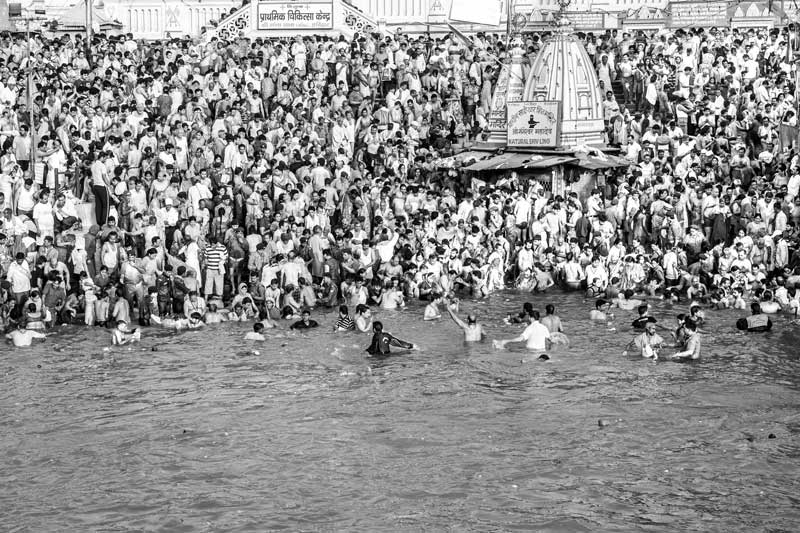
Water and culture are intricately related. In Indian culture, the sacred value of water has always held a central position, Kumbh being an important manifestation. Essentially a water pilgrimage (Jal Tirth), Kumbh is India's oldest and most famous ritual bathing festival, reference to which is found in the Rig Veda (1700-1100 BC). Being held at the same place every 12 years, Kumbh has four venues, namely Haridwar, Ujjain, Nashik and Prayag (Allahabad) along the sacred rivers Ganga, Godavari, Kshipra and at the confluence of Ganga, Yamuna and Saraswati respectively. It is reckoned as the world's largest peaceful religious congregation where millions of people travel from all corners of the country and undertake the Kumbh Snan - holy bath in the sacred river water. So far the biggest congregation recorded is at Prayag in 2013 where more than 120 million people are estimated to have taken the holy dip. While bathing in holy waters of Ganga, Yamuna, Kshipra and Godavari is always considered auspicious and liberating, the Kumbh Snan is seen as having a special ritual value. This sacred bath is believed to enable purification of the body and soul, liberation from sins, and emancipation from the cycle of re-births and death. This is enabled by the special zodiac alignments during the Kumbh which triggers the holy waters of the river with Cosmic Energy that effects a change in the mind, body and spirit, thereby affecting the human destinies for the better. For this reason, bath at Kumbh is considered as moksha-daayi – i.e., giver of salvation. Kumbh has exhibited different forms at different times in history and continues to evolve, but the spirit and purpose of the celebration continues unabated. The Kumbh festival explicitly demonstrates that water is not only an economic good nor is it enough to consider it as a social good, but there is a need to emphasize its sacred and spiritual value. However, in recent times, the sacred waters in the rivers at the Kumbh venues are increasingly facing a challenge due to diminishing quantities and deteriorating quality. During Kumbh, other water uses are often curtailed in the area in order to maintain adequate and clean water flow in the river. If this state of affairs is allowed to continue, the fulfilment of this important ritual function of these holy rivers may become difficult, disrupting celebration of this great water pilgrimage, in turn affecting Indian religious and cultural ethos. This calls for effective management of river waters so that this unique bathing festival can be sustained through generations. This photo story presents the varied dimensions of Kumbh across its different venues, highlighting the deep interconnection between water and religion. The title photo is of Kumbh Snan on the banks of river Ganga at Har ki Pauri, Haridwar, Uttarakhand.
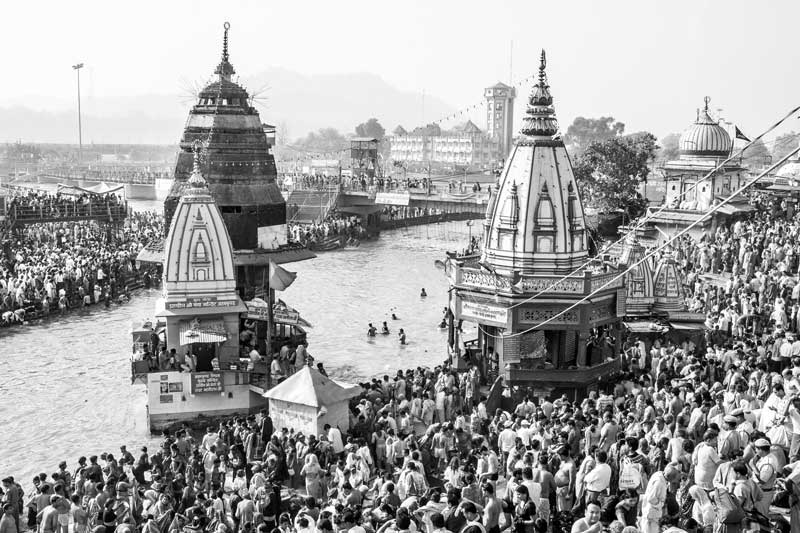
Conglomeration of devotees for Kumbh Snan on the banks of river Ganga at Har ki Pauri, Haridwar, Uttarakhand
The word kumbh means 'pot' and ritually it symbolizes the Amrit Kumbh (pot of nectar of immortality), obtained after churning of the eternal ocean jointly by the Devataas (Gods) and Asurs (demons). According to religious scriptures, the sight of Amrit Kumbh led to a fierce battle between the Gods and demons during which the pot of nectar was placed at Haridwar, Ujjain, Nashik and Prayag (Allahabad), along the sacred rivers Ganga, Godavari, Kshipra and at the confluence of Ganga, Yamuna and Saraswati respectively. While being moved, drops of nectar spilled out and mixed with river water at these places, making these the centers of Kumbh Snan. The battle lasted 12 days for the Gods which equals 12 years in human time, hence Kumbh is held at the same venue every 12 years. At Haridwar and Prayag this occasion is known as Purna Kumbh (full kumbh), since every six years there is also an Ardha Kumbh (half kumbh). The Kumbh dates are astrologically calculated on the basis of alignment of zodiacal positions of the Sun, Moon and Jupiter.
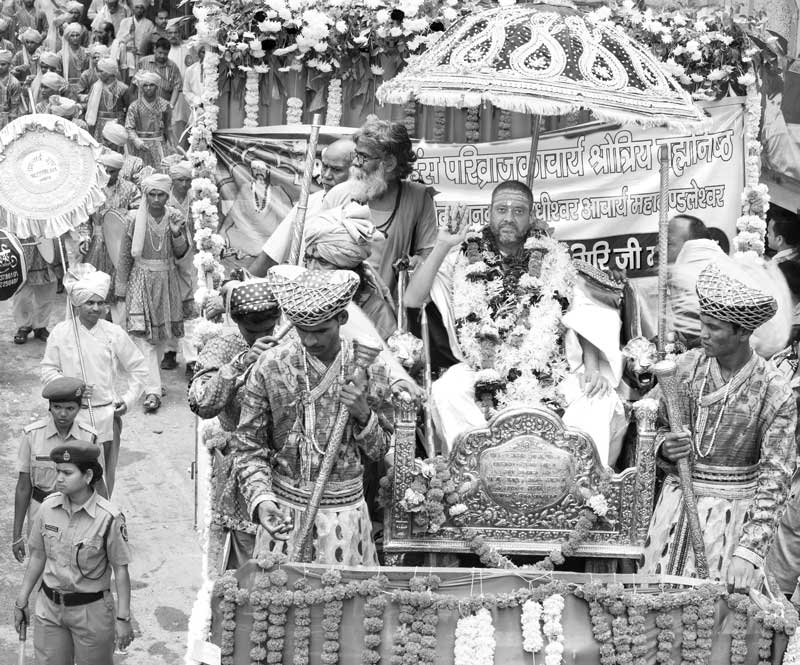
Peshwai of Anand Akhara in Nasihk Kumbh at Trimbakeshwar, Nashik district, Maharashtra
An important dimension of the Kumbh is the Peshwai which denotes the royal procession of holy men that marks the arrival of the members of an akhara at the Kumbh. Akharas are monastic institutions created by Adi Shankaracharya in 8th Century AD. Each Akhara holds its own Peshwai where Naga Sadhus (naked ascetics), the Mahamandaleshwars (the great spiritual leaders), and other monks and spiritual leaders of the Akhara move on chariots, horses or on foot along with their ceremonial flags, deities, holy symbols and followers in a procession along the town streets, accompanied by musical instruments and dance.
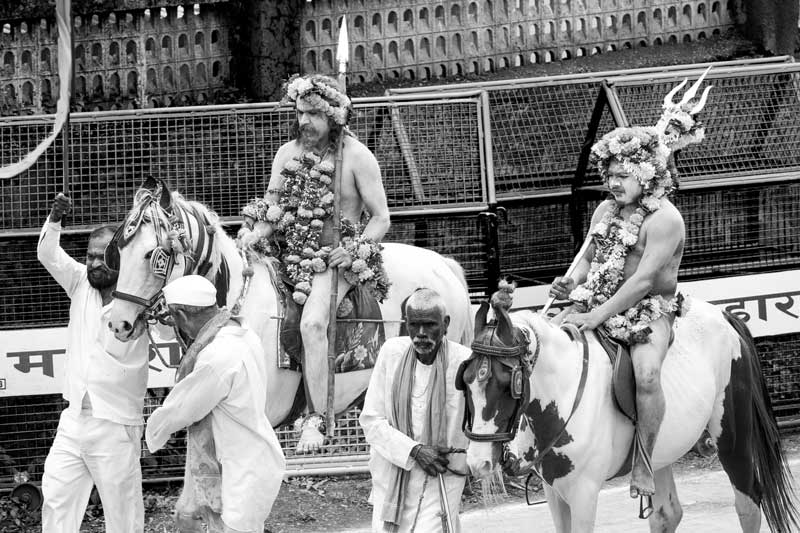
Naga Sadhus of Anand Akhara during Peshwai in Nashik Kumbh at Trimbakeshwar, Nashik district, Maharashtra
The Naga Sadhus (naked ascetics) are Shaivite saints who represent an armed order that acted as Hindu soldiers in the past. They hold tridents (trishul), spears and swords; their bodies are smeared in thick ash and they wear heavy coils of matted hair on the head.
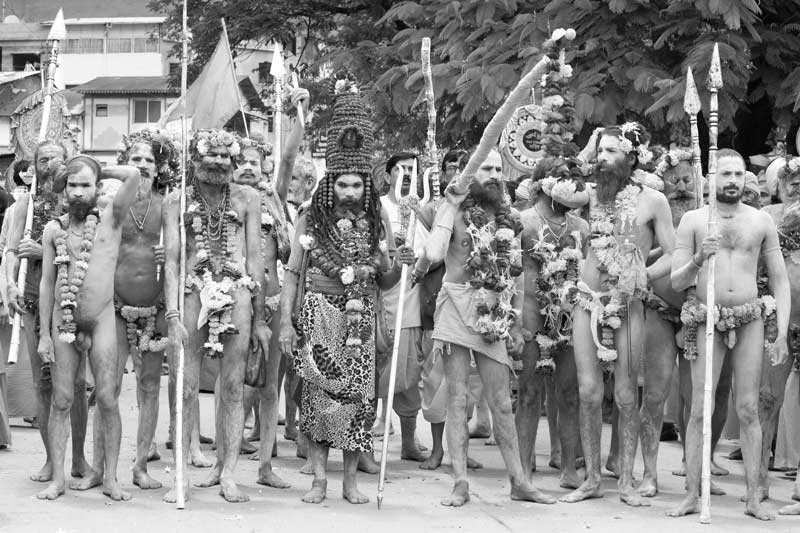
Naga Sadhus of Anand Akhara during Peshwai in Nashik Kumbh at Trimbakeshwar, Nashik district, Maharashtra
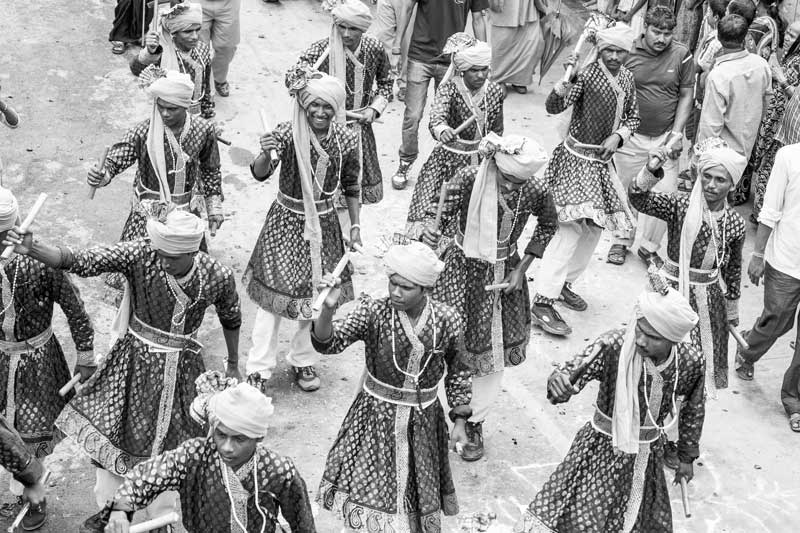
A traditional dance being performed during Peshwai in Nashik Kumbh at Trimbakeshwar, Nashik district, Maharashtra
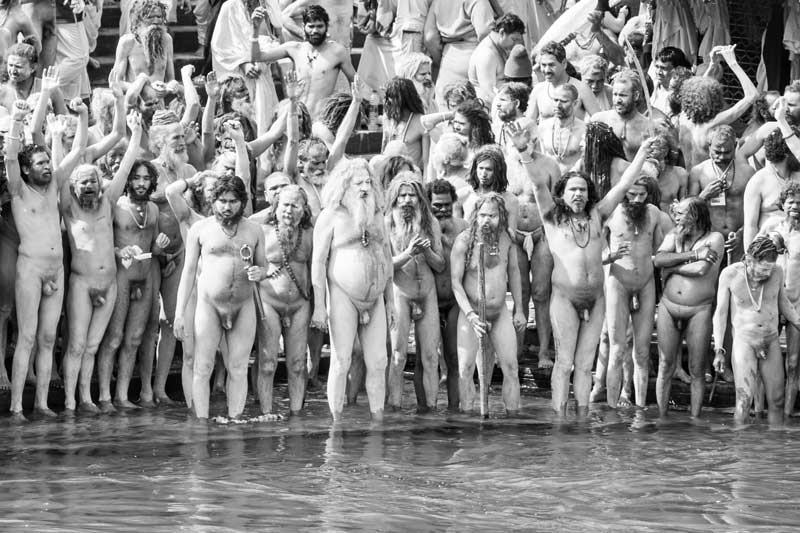
Naga Sadhus venerating the river and God Almighty before initiating the holy dip in river Ganga during Shahi Snan at Har ki Pauri, Haridwar, Uttarakhand
Another important dimension of the Kumbh Snan is the Shahi Snan or the royal bath which is organized on certain specific auspicious dates. It is called royal because on this occasion all 'akharas proceed in a grand procession for the bath. At Shahi Snan, the Naga Sadhus occupy a place of privilege and initiate the bathing rituals at the Kumbh. The other important groups are of the Mahamandaleshwars and other monks and religious leaders of the Akhara. All holy persons offer prayers to the river and God Almighty and take the holy dip. Only after Shahi Snan of the akharas is over, the general public can step in for the holy bath on these special dates.
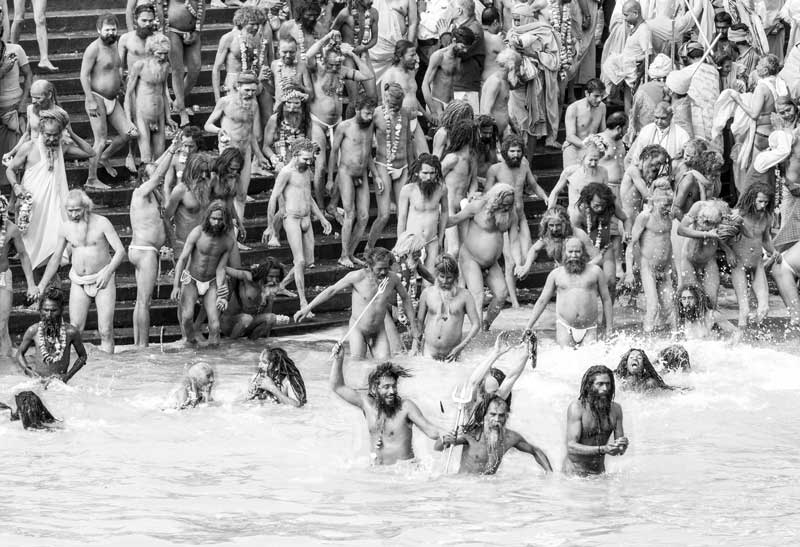
Naga Sadhus performing Shahi Snan in river Ganga at Har ki Pauri, Haridwar, Uttarakhand
At Haridwar, the Shahi Snan takes place at the Har ki Pauri (steps of Lord Hari) where Brahma Kund (sacred tank of Almighty) is located. This spot is regarded as the most sacred point at Haridwar because drops of nectar of immortality are believed to have fallen here.
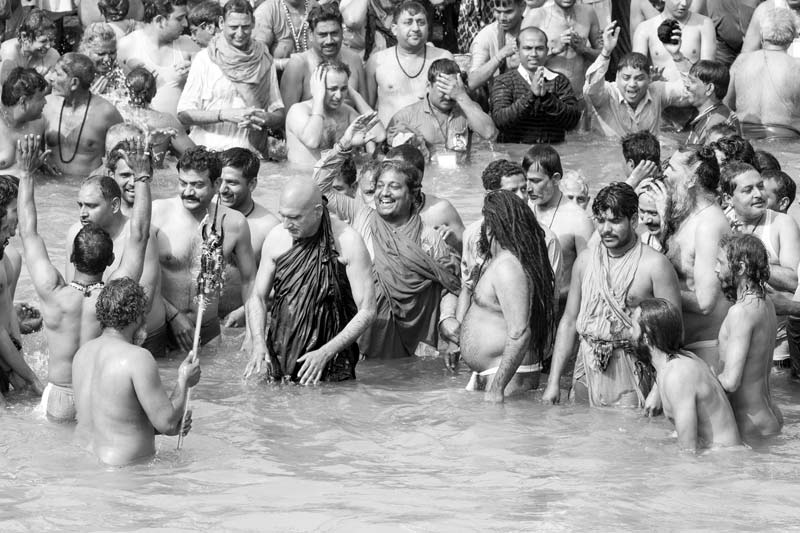
Acharya Mahamandaleshwar Swami Sri Avadheshanand Giriji of Juna Akhara performing Shahi Snan in river Ganga along with his disciples at Har ki Pauri, Haridwar, Uttarakhand
While the holy men step into the river for the Shahi Snan, their followers also join in the hope of getting greater virtues as well as blessings of their religious gurus (teachers).
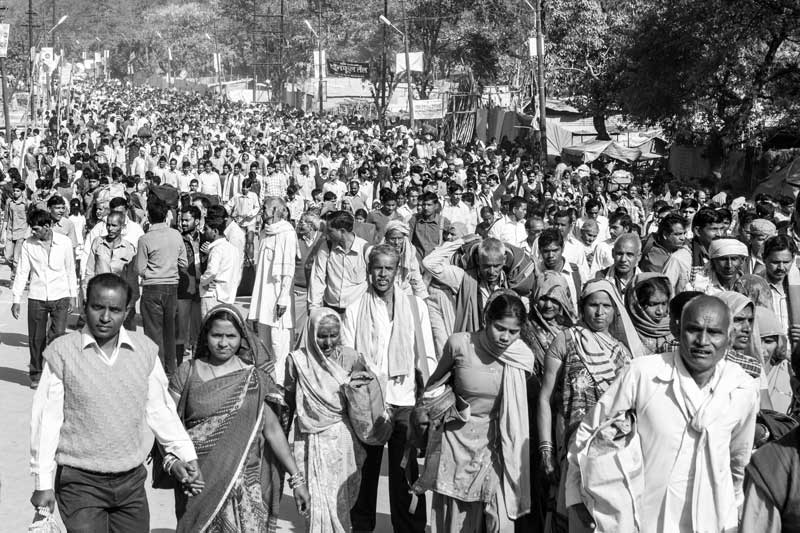
Pilgrims walking to the bathing ghat for undertaking Kumbh Snan at Prayag (Allahabad), Uttar Pradesh
Millions of pilgrims come to Kumbh from different states of India to undertake the Kumbh Snan. They arrive by different modes of transport round the clock, withstanding all physical discomforts. They come by train, bus, car, truck, tractor, bullock cart, bicycle and even donkey. Many thousands travel by foot, even without shoes, and at the Kumbh one can see endless procession of men, women and children walking with a single desire and faith- that the holy bath will cleanse them of all sin and give them better destinies. At the recently concluded Simhastha-Kumbh held in Ujjain in 2016, more than 75 million people are estimated to have undertaken the Kumbh Snan.
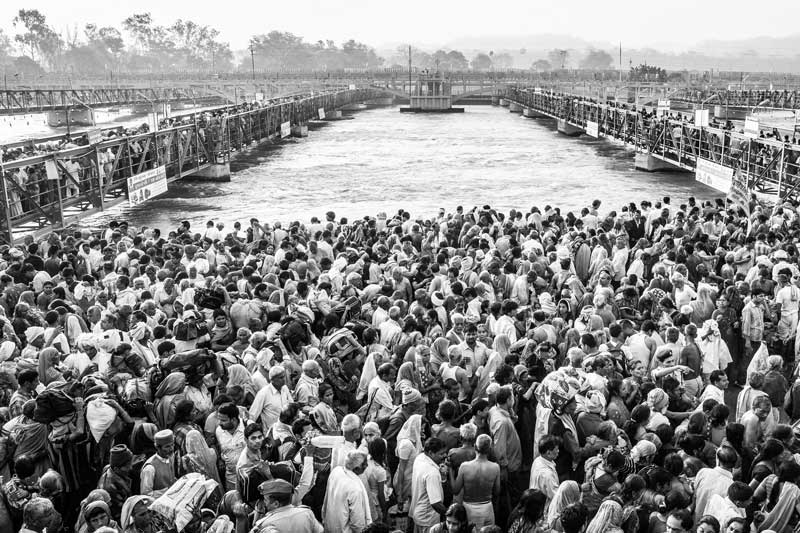
Rush of pilgrims for Kumbh Snan in river Ganga at Har ki Pauri, Haridwar, Uttarakhand
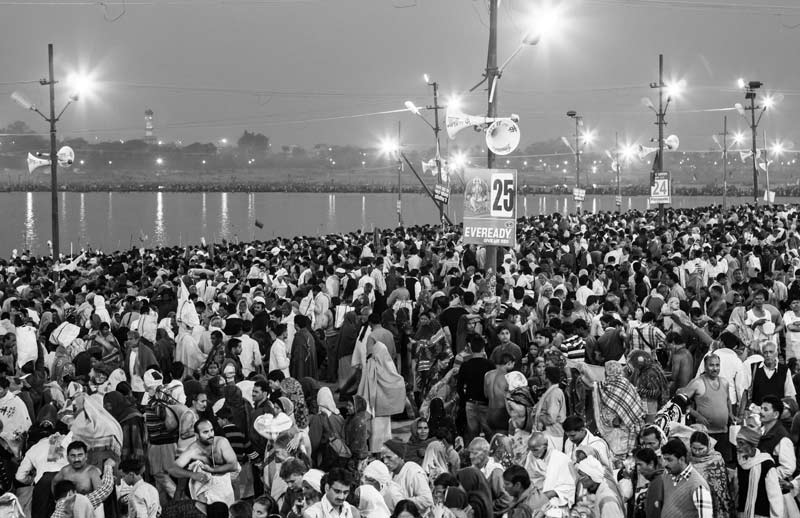
Rush of devotees for Kumbh Snan at dawn at the confluence of rivers Ganga, Yamuna and Sarasvati in Prayag (Allahabad), Uttar Pradesh
Kumbh Sanan continues non-stop round the clock during the entire festival period.
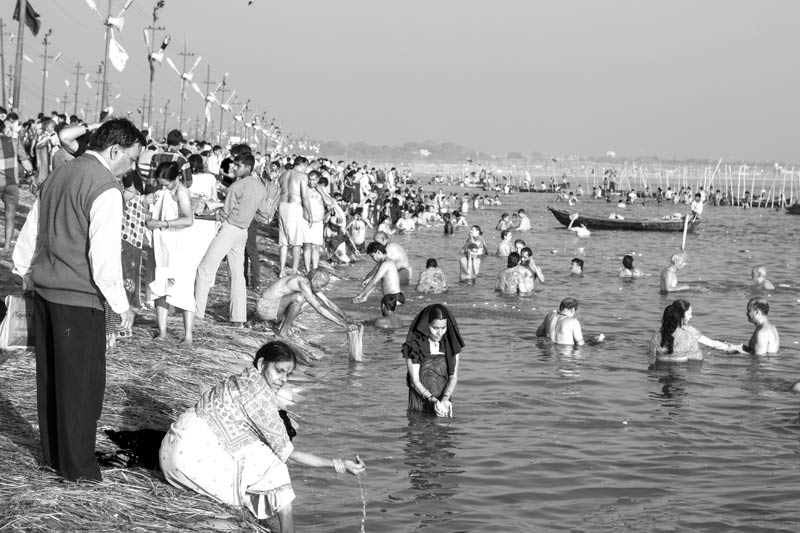
Pilgrims performing Kumbh Snan at the confluence of rivers Ganga, Yamuna and Sarasvati in Prayag (Allahabad), Uttar Pradesh
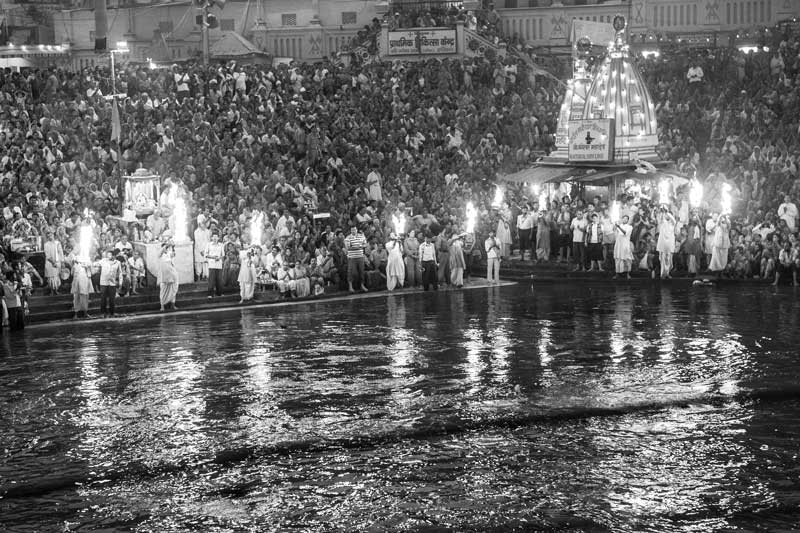
Evening Aarti on the banks of river Ganga at Har ki Pauri, Haridwar, Uttarakhand
Every evening at Kumbh the holy river is venerated by priests using lighted lamps accompanied by singing of prayers at an event called aarti. At Haridwar the main Aarti is held on the banks of river Ganga at Har ki Pauri, while at Prayag it is held on the banks of Sangam where sacred rivers Ganga, Yamuna and Saraswati meet. At Nashik, the evening Aarti takes place at Ramkund on the banks of river Godavari, while in Ujjain the venue is at Ram Ghat on the banks of river Kshipra. Hundreds of thousands of devotees join this event and also offer flowers and lamp at the river, a practice which has continued over centuries.
The Aarti on the river banks at Kumbh is a manifestation of the recognition of the spiritual and sacred value of water in Indian culture. The traditional knowledge system on water in Indian society has always respected this value as exemplified by the classification of 'sacred' and 'secular' water bodies. The holy rivers on the banks of which Kumbh is celebrated are representative of the sacred water bodies in India. Continuity of rituals and cultural practices that promote the sacred value of water in society in turn has the potential to reinforce efforts towards sustainability of water at a broader scale. In this light, it is important that efforts be made to sustain the water flow and protect the water quality of the holy Kumbh rivers so that the traditional values concerning water and the ritual reinforcing this value can continue through generations. In turn this will enable the civilization to grow, develop and sustain.